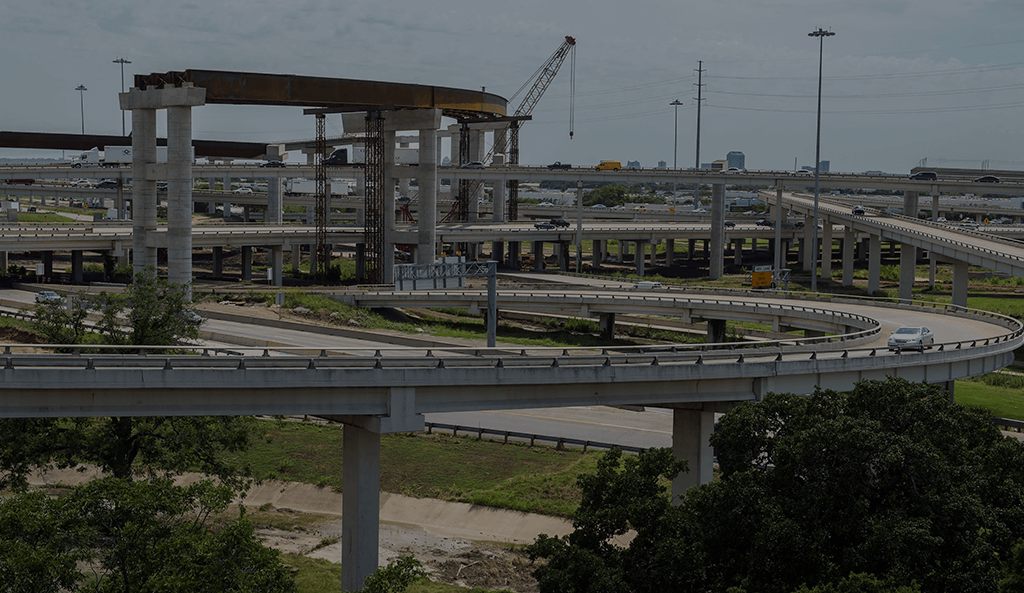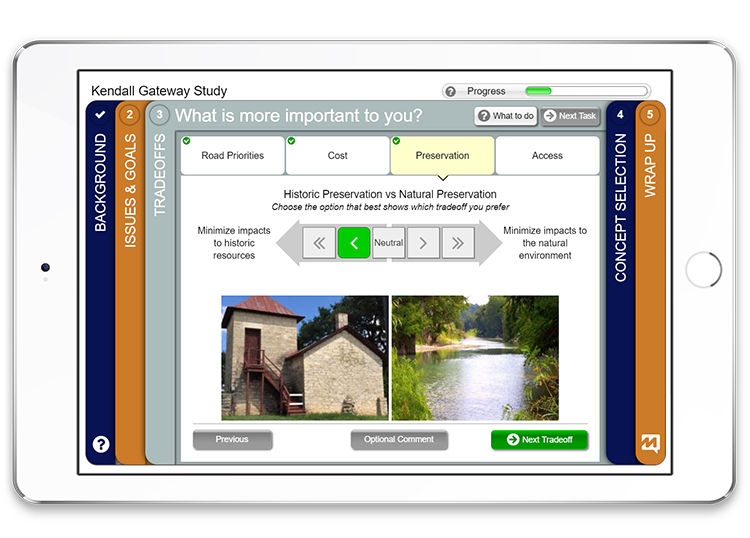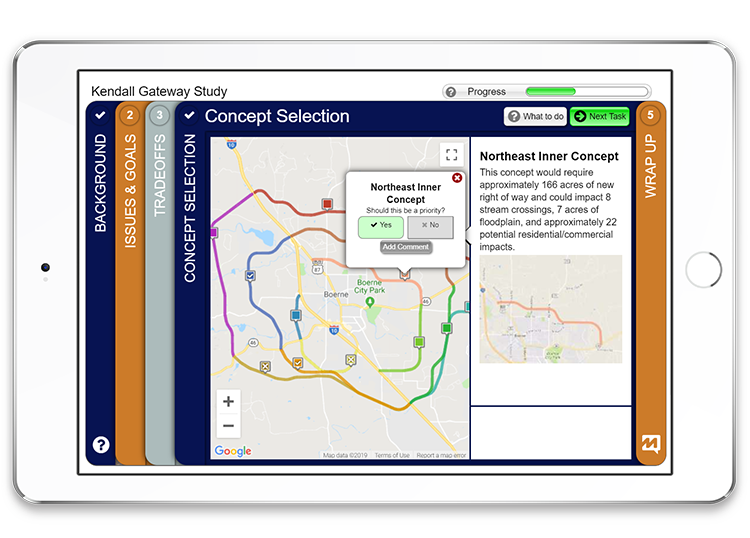TxDOT involves over 7,700 Texans in planning!
“Online engagement provides the hook, so to speak, needed to capture the public’s attention. Constituents are able to provide input in a meaningful manner and on issues that are important to them, and do it quickly, and of course, at their own convenience. It has greatly increased the reach of our public involvement efforts across many projects.” – Jefferson Grimes, Director of Public Involvement, TxDOT
Congratulations on your success in involving so many Texans statewide!
An agency with progressive values, the Texas Department of Transportation (TxDOT) is highly committed to fostering meaningful public involvement in planning and project implementation. Metroquest has helped TxDOT to:
With MetroQuest, the COMPASS team achieved:

About TxDOT
Responsible for maintaining 80,000 miles of road, the Texas Department of Transportation also supports aviation, rail, and public transportation across the state to serve a growing population nearing 29 million.
In 2011, the Texas Transportation Commission made it policy to “regularly update public involvement methods to include best practices and incorporate a range of strategies to encourage broad participation reflective of the needs of the state’s population.” At that time, the Transportation Planning and Programming Division tasked the public involvement team with enabling early, continuous, and transparent public access to information and decision-making processes for transportation projects at all scales.
CHALLENGE: Engaging communities throughout the State of Texas.
The State of Texas is home to 254 different counties, 180,000 lane miles, 53,000 bridges, and 27 international ports of entry. “Texas is very big geographically and culturally diverse. We pride ourselves not only in our outsized thinking, but also in thinking in a way that’s very reflective of our diverse population,” said Jefferson Grimes, Director of Public Involvement.
“And that population has the same type of outsized expectations of us as transportation providers. We take those expectations to heart here at TxDOT in the area of civic engagement. That’s why we need to take every opportunity to gather input from the public.”
TxDOT explored online public engagement as a modern method to involve the public in a wide variety of projects across the state. “It was our agency’s goal to provide an online platform for meaningful exchange of thoughts and ideas to help us arrive at decisions that truly represent the desires and needs of Texans,” explained Jefferson, “A dedicated online citizen engagement tool would help us meet the expectations of our public.”
SOLUTION: MetroQuest compels Texans to get involvement online!
“Let’s face it. Our attention span is directly proportioned to how interesting whatever we are focusing on at the moment is,” Jefferson described how MetroQuest addresses this truism by creating a compelling online public engagement experience.
“Online engagement provides the hook, so to speak, needed to capture the public’s attention. Constituents are able to provide input in a meaningful manner and on issues that are important to them, and do it quickly, and of course, at their own convenience.”
Julie Jerome, who works on Jefferson’s team as Public Involvement Specialist, highlighted one of her projects. “The El Paso district engagement efforts paint a quintessential picture of how TxDOT districts all over the state are embracing and utilizing online engagement as part of an overall public involvement strategy,” said Julie. “Major construction projects totalling nearly one billion dollars are underway in the district. We used online surveys to gather public input on four corridor studies.”
The El Paso District engaged three communities with MetroQuest surveys that featured Strategy Rating, Priority Ranking, and Image Rating Screens. The public input gathered helped inform the corridor designs to improve drainage, safety, traffic, multi-modal, and aesthetics in a way more closely aligned with the vision of the local communities served. “The public spoke, and priorities shifted,” Julie explained,
“This approach really showcased the visual aspects of the tool as we offered distinct styles and looks for each of the communities. It was a powerful way for the public to visualize what their communities could look like with the improvements.”

TXDOT WEBINAR
Public Involvement – How TxDOT Engages Beyond Meetings
Learn how TxDOT embraces innovation to successfully educate and engage residents on projects at any scale.
TxDOT shows commitment to public involvement across the state.
TxDOT has launched nearly 30 engaging MetroQuest surveys, collecting quantifiable data and gaining new insights state-wide. “One of the things that we like about online engagement is that it truly does put us in listening mode. The public is speaking, and we are listening,” said Jefferson,
“Online engagement has solved communication challenges that range from polling a small working group to more wide-ranging input from the public across numerous jurisdictions. It has greatly increased the reach of our public involvement efforts across many projects.”
MetroQuest is empowering TxDOT to collect quantifiable data at public meetings, but also to go beyond in-person events to engage the broader community. “We provided interactive kiosks at the FM 2810 public meeting that encouraged public input. We also promoted the survey through the media, social media, and a series of email campaigns. We’re really excited about the 444 participants who provided feedback that we may not have received otherwise,” said Allison Kurwitz, Transportation Engineering Supervisor for advance planning in the Bryan District.
“The results from the survey showed that the proposed plan was on track in addressing the public’s priorities and highlighted additional improvements for consideration.”
Michael Bolin, Deputy District Engineer for Waco District explained how he is using MetroQuest data to align investment decisions with public priorities. “By allowing the community to rank the goals and objectives of the US 190 Feasibility Study,” he said, “the project team can better understand community values and concerns. This input will allow the project team to make better decisions.”
Amy Redmond, a Public Involvement Specialist on Jefferson’s team described her success with MetroQuest. “It provided easy-to-use quantitative data in charts and graphs that helped drive decisions on the technical aspects of the study. For example, the public preferred the fastest route over the shorter. They wanted a roadway with more access and a lower speed compared to less access and higher speed,” said Amy.
“We gathered meaningful input from 1,124 participants! Online engagement enables TxDOT to actually listen to the public and provide data to show the public that their concerns and recommendations are heard and used in decision-making.”
RESULT: Over 7,700 Texans engaged in transportation planning!
“Measures of success for us in public involvement essentially comes down to three things: how well our efforts increase reach, inform the audience, and of course, fundamentally spur interest in providing feedback, because that is what we’re looking for,” explained Jefferson.
Today, TxDOT relies on MetroQuest for quantifiable input to inform better transportation investment decisions state-wide. “The quality and effectiveness of this data is a critical component to the success of public engagement initiatives and can have a positive long-term impact on TxDOT’s planning and project development,” Jefferson described the value of the outstanding public involvement results his team has achieved.
“Because informed input is the greatest kind of input, the tool is designed to first educate the public about a project and then quickly collect their informed feedback. What we’ve seen is that incorporating online citizen engagement has been a resounding success so far.”
While TxDOT continues to launch new MetroQuest surveys almost weekly, the agency has already achieved outstanding public involvement results. Jefferson and his team have engaged over 7,730 residents, collected more than 120,750 quantitative data points, and captured 8,450 comments to inform and gain public support for projects across the state.
Texas is one of many states and regional agencies using MetroQuest to provide the easiest and most engaging method to involve the public in building better transportation networks. Congratulations Jefferson to you and your team for your outstanding online public involvement!

